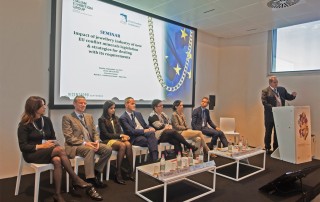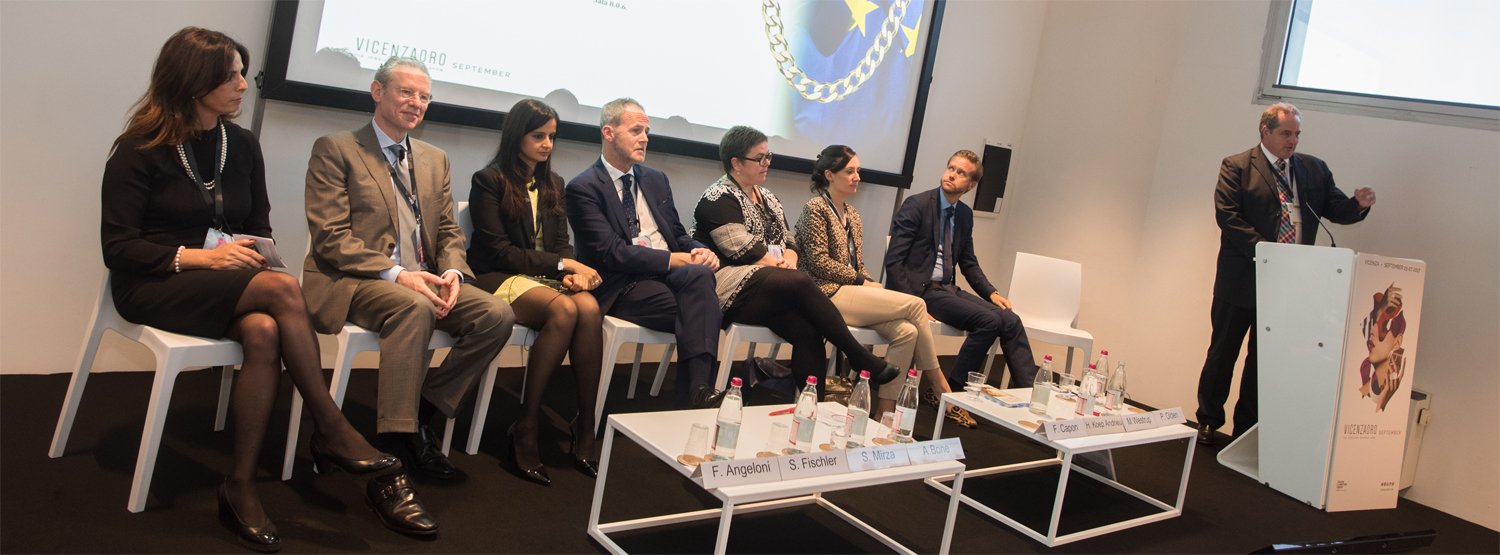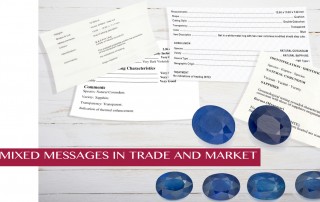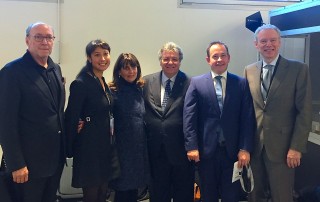Industry leaders endorse jewellery and gemstone sector’s ‘duty of care’ at seminar in Vicenza studying impact of EU conflict minerals law
ABOVE: Philip Olden, the seminar moderator, introducing the panel of speakers in the seminar on the impact of the new EU conflict minerals regulations, which took place in Vicenza on September 24. (PHOTO CREDIT: La Presse)
SEPTEMBER 28, 2017
The significance and potential impact on the jewellery industry of Regulation (EU) 2017/821, which will control the import into the European Union of gold, tin, tantalum and tungsten from conflict and high-risk areas, came under the spotlight at a seminar for the jewellery industry in Vicenza on September 24, organised by CIBJO and the Italian Exhibition Group.
Participants were welcomed by Gaetano Cavalieri, CIBJO’s President, and by Matteo Marzotto, IEG’s Executive Vice President.
The seminar, which was moderated by Philip Olden, a consultant to Signet Jewelers and the former managing director of the World Gold Council, brought together a panel of expert speakers, representing government, international and European organisations, business standards organisations and the jewellery, precious metals and gemstone industries.
Panel members included Marten Westrup, Coordinator of Energy and Raw Materials at the European Commission, DG Trade; Hannah Koep-Andrieu, Policy Adviser-Extractives in the Responsible Business Conduct division at the Organisation for Economic Co-operation and Development (OECD); France Capon, Secretary General of the European Precious Metals Federation (EPMF); Andrew Bone, Executive Director of the Responsible Jewellery Council (RJC); Sakhila Mirza, Executive Board Director and General Counsel of the London Bullion Market Association (LBMA); Stephane Fischler, Acting President of the World Diamond Council (WDC); and Francesca Angeloni, Business Development Manager Europe Jewellery and Watch Industry in the Consumer & Retail Services division of UL.
While the regulatory regime established by the new law will be fully enforced only from January 2021, providing sufficient time for businesses to adapt to its provisions, its basic framework has been outlined in the legislation that was passed by the European Parliament in May. But there are still benchmarks, procedures and requirements that need to be formulated by the European Commission, which will be providing guidance to the business community in the months ahead. This will include a white list of approved refineries and smelters, located both inside and outside of the EU, from which purchases of gold will not trigger automatic third-party auditing requirements.
Mr. Westrup explained that the EU’s approach to conflict minerals and the recently enacted regulation has the main objective of ensuring sufficient supply chain due diligence in imports of gold and 3Ts from conflict-affected and high-risk areas. He noted that the four-year lead-in time before the requirements are to be met and the setting of thresholds below which importers are exempt from the legal requirements for due diligence are in part meant to meet the concerns of small and medium-sized enterprises. He explained that the thresholds set out in the regulation (100 kilogram per annum for gold) are intended to ensure that at least 95 percent of imports of each metal or mineral are covered, while at the same time underlining that companies without legal obligations under the EU regulation also should carry out due diligence as far as possible.
Ms. Koep-Andrieu noted that the five-step process outlined in the OECD’s Due Diligence Guidance for Responsible Supply Chains of Minerals from Conflict-Affected and High-Risk Areas forms the basis of the new EU regulations, and that all companies could begin integrating its requirements into their systems of management, so as to become compliant with the new regime before 2021, regardless of size. She also pointed out that the guidance is applicable to all minerals, and not only gold and the 3Ts.
Ms. Capon outlined the efforts already taken by the members of the European Precious Metals Federation to ensure that the gold they are importing is subject to the type of due diligence outlined in the new EU regulations. She also was critical about the 100-kilogram threshold, saying that it undermined the efforts of other companies seeking to become compliant, while suggesting that it be reduced significantly or eliminated completely.
Noting that membership in the Responsible Jewellery Council has long passed the 1,000-company mark, Mr. Bone described the organisation as the leading responsible business standards organisation in the jewellery sector. The RJC Code of Practices, which is an international standard of responsible business practices for diamonds, gold and platinum group metals, accommodates the OECD guidelines, and, if one is RJC-certified, compliance with the new EU regulations will be easily achieved, he said.
Ensuring the integrity of the precious metals market, Ms. Mirza, said that LBMA’s Responsible Gold Guidance helps ensure the long-term integrity of the wholesale gold business. The LBMA good delivery list, which is widely recognised as the de facto standard for precious metals markets around the world as to what refiners’ gold and silver bars are acceptable, today includes 71 gold refiners from 31 countries, accounting for 85 percent to 90 percent of world production. Its due diligence standards are also compliant with the OECD guidance document, she said.
Relating the experience of the diamond industry in implementing a rigid regulatory system to stem the flow of minerals financing conflict, Mr. Fischler noted that the Kimberley Process Certification Scheme differs from the EU regulations in that places a significant burden on government, while the European system focuses its attention predominantly on company self-regulation. Nonetheless, he added, while government is more directly involved in monitoring rough diamond imports and exports, diamond companies still need do due diligence, both in maintaining records of KP certificates in the rough diamond trade, and in complying with the WDC System of Warranties in the polished diamond business. While the approach of the Kimberley Process differs from that of the OECD guidance, Mr. Fischler said he is supportive of the principles expressed in the OECD document, and stressed that the industry in general needs to promote a mutual commitment to “a duty of care.”
Ms. Angeloni provided the perspective of one of the largest companies conducting third-party audits in the jewellery industry, presenting a checklist of procedures that companies will need to undergo in order to achieve compliance with the new EU regulations. She also announced that UL is developing a toolkit together with CIBJO, which will serve as a roadmap for companies in navigating the new regulatory regime.
In his concluding remarks, Mr. Olden remarked that, while the introduction of the EU regulations will represent a formative moment for both the precious metals and jewellery sectors, the seminar demonstrated that systems are already in place to make compliance more achievable than some may have feared. “If you insist that your bank buy only from LBMA-approved refiners, and you are certified by a code of practices such as that of the Responsible Jewellery Council, then in all likelihood you will have in place all the various elements required to become compliant,” he said.
Mr. Olden proposed that the speakers on stage endorse the following statement: “This panel supports the principles of duty of care and supply chain due diligence. We encourage participants in the jewellery supply chain to engage with industry organisations to ensure compliance with industry guidance and standards relating to responsible sourcing.” The speakers supported the resolution.
All presentations delivered at the seminar can be downloaded from the CIBJO website. To link to the seminar report on the website, please CLICK HERE.




















